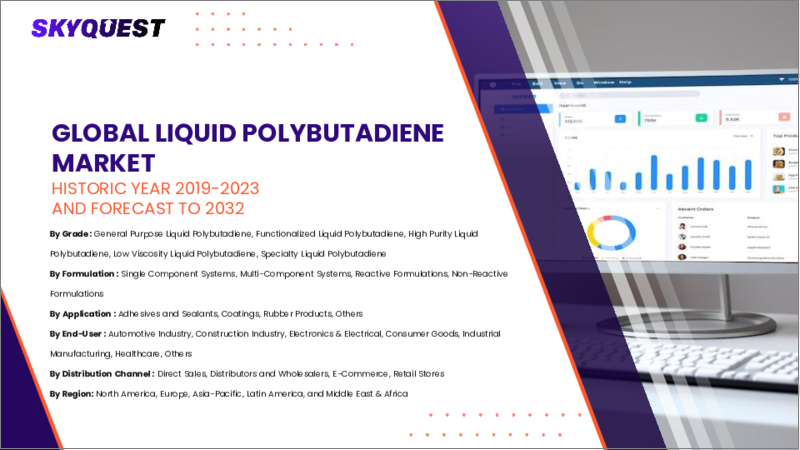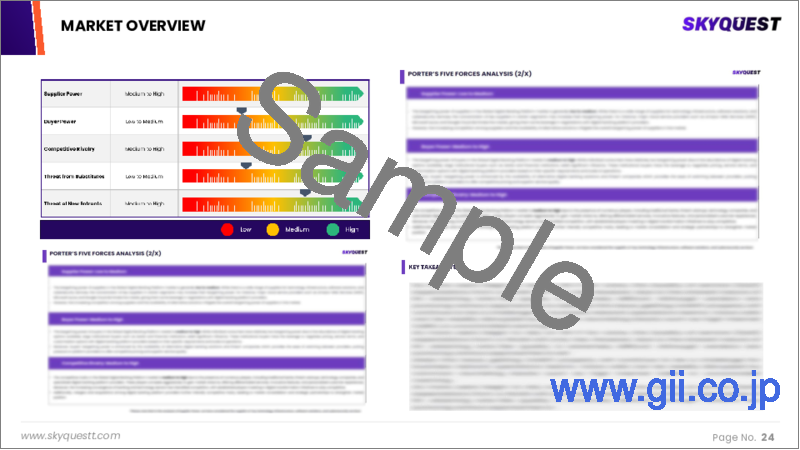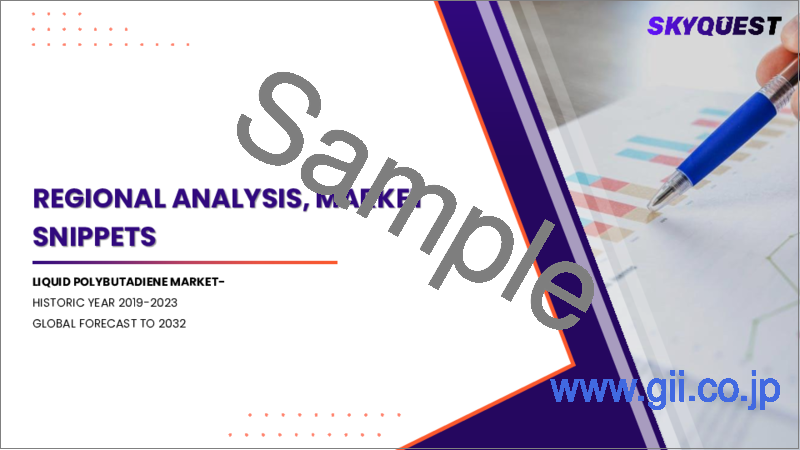|
|
市場調査レポート
商品コード
1603495
液状ポリブタジエンの市場規模、シェア、成長分析、用途別、エンドユーザー別、地域別- 産業別予測2024-2031Liquid Polybutadiene Market Size, Share, Growth Analysis, By Application (Adhesives & Sealants, Polymer Modification), By End-User (Automotive, Construction), By Region - Industry Forecast 2024-2031 |
||||||
|
|||||||
| 液状ポリブタジエンの市場規模、シェア、成長分析、用途別、エンドユーザー別、地域別- 産業別予測2024-2031 |
|
出版日: 2024年11月24日
発行: SkyQuest
ページ情報: 英文 184 Pages
納期: 3~5営業日
|
全表示
- 概要
- 目次
液状ポリブタジエンの世界市場規模は2022年に39億米ドルと評価され、2023年の41億米ドルから2031年には61億5,000万米ドルに成長し、予測期間(2024-2031年)のCAGRは5.2%で成長する見通しです。
世界の液状ポリブタジエン(LPBD)市場は、タイヤ用途での需要の高まり、建設用途での使用量の増加、天然ゴム代替品への嗜好の高まりなどの要因が重なり、近年著しい成長を遂げています。特に、熱硬化性プラスチック、特にポリエステル樹脂の硬化と取り扱いに液状ポリブタジエンの採用が増加していることが、市場を後押ししています。しかし、プラスチックに関する厳しい環境規制がこの分野の成長を妨げる課題となっており、実行可能な解決策として生分解性プラスチックや石油系プラスチックへのシフトを促しています。石油由来の合成ゴムのユニークな粘弾性特性は、タイヤ製造におけるLPBDの重要な役割をさらに後押しし、LPBDは今後も力強い成長を遂げると思われます。その他の特典として、自動車産業が低転がり抵抗タイヤや高性能タイヤへのシフトを進めていることに加え、バイオ接着剤の人気が高まっていることや、タイヤ製造におけるバイオベースのコンポーネントの統合が進んでいることも、LPBD市場に利益をもたらしています。しかしながら、LPBD市場は、原油価格の変動や原材料コストの変動など、収益性に影響を与えかねない課題を克服しなければなりません。全体として、LPBD市場は拡大基調にあるが、利害関係者は将来のビジネスチャンスに向けて戦略を練る際、規制圧力や市場の不安定性を考慮する必要があります。
目次
イントロダクション
- 調査の目的
- 調査範囲
- 定義
調査手法
- 情報調達
- 二次データと一次データの方法
- 市場規模予測
- 市場の前提条件と制限
エグゼクティブサマリー
- 世界市場の見通し
- 供給と需要の動向分析
- セグメント別機会分析
市場力学と見通し
- 市場概要
- 市場規模
- 市場力学
- 促進要因と機会
- 抑制要因と課題
- ポーター分析と影響
- 競争企業間の敵対関係
- 代替品の脅威
- 買い手の交渉力
- 新規参入業者の脅威
- 供給企業の交渉力
主な市場の考察
- 重要成功要因
- 競合の程度
- 主な投資機会
- 市場エコシステム
- 技術の進歩
- 規制情勢
- バリューチェーン分析
- ケーススタディ分析
- 顧客と購買基準の分析
- PESTEL分析
- マクロ経済指標
- 市場の魅力指数
- 原材料の分析
- 価格分析
液状ポリブタジエンの市場規模:用途別& CAGR(2024-2031)
- 市場概要
- タイヤ製造
- 工業用ゴム
- ポリマー改質
- 保護フィルム
- 化学薬品
- コーティング
- 接着剤とシーラント
- その他
液状ポリブタジエンの市場規模:エンドユーザー別& CAGR(2024-2031)
- 市場概要
- 自動車
- 建設
- 産業
- その他
液状ポリブタジエンの市場規模& CAGR(2024-2031)
- 北米
- 米国
- カナダ
- 欧州
- 英国
- ドイツ
- スペイン
- フランス
- イタリア
- その他欧州地域
- アジア太平洋
- 中国
- インド
- 日本
- 韓国
- その他アジア太平洋地域
- ラテンアメリカ
- ブラジル
- その他ラテンアメリカ地域
- 中東およびアフリカ
- GCC諸国
- 南アフリカ
- その他中東・アフリカ
競合情報
- 上位5社の比較
- 主要企業の市場ポジショニング(2023年)
- 主な市場企業が採用した戦略
- 市場の最近の動向
- 企業の市場シェア分析(2023年)
- 主要企業の企業プロファイル
- 会社概要
- 製品ポートフォリオ分析
- セグメント別シェア分析
- 収益の前年比比較(2021-2023)
主要企業プロファイル
- Cray Valley(TotalEnergies)
- Kuraray Co., Ltd.
- Evonik Industries
- Synthomer Plc
- Nippon Soda Co., Ltd.
- Idemitsu Kosan Co., Ltd.
- Efremov Synthetic Rubber Enterprise
- Tianyun Chemical Research
- SIBUR Holding
- UBE Industries Ltd.
- Zeon Corporation
- JSR Corporation
- Lion Elastomers
- Arlanxeo
- Polysar GmbH
- Nizhnekamskneftekhim PJSC
- China National Petroleum Corporation(CNPC)
- Kumho Petrochemical
- SK Global Chemical Co., Ltd.
- LG Chem
結論と推奨事項
Global Liquid Polybutadiene Market size was valued at USD 3.9 Billion in 2022 and is poised to grow from USD 4.1 Billion in 2023 to USD 6.15 Billion by 2031, growing at a CAGR of 5.2% during the forecast period (2024-2031).
The global liquid polybutadiene (LPBD) market has experienced notable growth in recent years, driven by a confluence of factors including heightened demand in tire applications, increasing usage in construction, and a growing preference for natural rubber alternatives. The market is particularly buoyed by the rising adoption of liquid polybutadiene in thermosetting plastics, especially for curing and handling polyester resins. However, stringent environmental regulations concerning plastics present challenges that may hinder segment growth, prompting a shift towards biodegradable and petroleum-based plastics as viable solutions. The unique viscoelastic properties of synthetic rubbers derived from petroleum further support LPBD's significant role in tire manufacturing, positioning it for continued robust growth. Additionally, the market is benefitting from the rising popularity of bio-adhesives and the integration of bio-based components in tire production, complemented by the automotive sector's increasing shift towards low-rolling resistance and high-performance tires. Nonetheless, the LPBD market must navigate challenges such as crude oil price volatility and fluctuating raw material costs that could impact profitability. Overall, while the LPBD market is poised for expansion, stakeholders will need to account for regulatory pressures and market instabilities as they strategize for future opportunities.
Top-down and bottom-up approaches were used to estimate and validate the size of the Global Liquid Polybutadiene market and to estimate the size of various other dependent submarkets. The research methodology used to estimate the market size includes the following details: The key players in the market were identified through secondary research, and their market shares in the respective regions were determined through primary and secondary research. This entire procedure includes the study of the annual and financial reports of the top market players and extensive interviews for key insights from industry leaders such as CEOs, VPs, directors, and marketing executives. All percentage shares split, and breakdowns were determined using secondary sources and verified through Primary sources. All possible parameters that affect the markets covered in this research study have been accounted for, viewed in extensive detail, verified through primary research, and analyzed to get the final quantitative and qualitative data.
Global Liquid Polybutadiene Market Segmental Analysis
Global Liquid Polybutadiene Market is segmented b, Application, End User and region. Based on application, the market is segmented into Tire Manufacturing, Industrial Rubber, Polymer Modification, Protective Films, Chemicals, Coatings, Adhesives & Sealants, and Others. Based on end user, the market is segmented into Automotive, Construction, Industrial, Others. Based on region, the market is segmented into North America, Europe, Asia Pacific, Latin America and Middle East & and Africa.
Driver of the Global Liquid Polybutadiene Market
One of the primary catalysts for the growth of the Global Liquid Polybutadiene market is the rising demand for high-performance rubber materials. These materials are prized for their superior characteristics, which include outstanding elasticity, durability, and strong resistance to chemicals and abrasion. Various sectors, such as automotive, construction, and coatings, rely significantly on these advanced rubber materials for a multitude of applications. This widespread dependency fuels the need for liquid polybutadiene, ultimately contributing to the market's expansion. As industries continue to seek materials that enhance performance and longevity, the demand for liquid polybutadiene is likely to increase further, propelling market growth.
Restraints in the Global Liquid Polybutadiene Market
The global liquid polybutadiene market encounters significant challenges stemming from stringent environmental regulations that oversee both the production and disposal of rubber materials. These regulatory pressures compel the industry to pursue the development of more sustainable alternatives, focusing on minimizing environmental impact. Manufacturers are increasingly adopting practices that comply with these rigorous standards, striving to innovate while ensuring that their operations align with the growing emphasis on sustainability and responsible environmental stewardship. As a result, the industry's ability to adapt to these constraints is crucial for its long-term viability and expansion in an increasingly eco-conscious market landscape.
Market Trends of the Global Liquid Polybutadiene Market
The Global Liquid Polybutadiene market is witnessing a notable trend towards sustainability, with increasing emphasis on bio-based alternatives. As environmental regulations tighten and consumer awareness grows, industries are actively seeking eco-friendly substitutes to traditional polybutadiene. Research and development initiatives focusing on bio-based materials are gaining traction, promising to reshape product formulations and manufacturing processes. This shift not only aligns with the global sustainability goals but also offers opportunities for innovative applications across various sectors, including automotive, adhesives, and coatings. As a result, the liquid polybutadiene market is poised for transformation, driven by the demand for greener, more sustainable options.
Table of Contents
Introduction
- Objectives of the Study
- Scope of the Report
- Definitions
Research Methodology
- Information Procurement
- Secondary & Primary Data Methods
- Market Size Estimation
- Market Assumptions & Limitations
Executive Summary
- Global Market Outlook
- Supply & Demand Trend Analysis
- Segmental Opportunity Analysis
Market Dynamics & Outlook
- Market Overview
- Market Size
- Market Dynamics
- Driver & Opportunities
- Restraints & Challenges
- Porters Analysis & Impact
- Competitive rivalry
- Threat of substitute
- Bargaining power of buyers
- Threat of new entrants
- Bargaining power of suppliers
Key Market Insights
- Key Success Factors
- Degree of Competition
- Top Investment Pockets
- Market Ecosystem
- Technological Advancement
- Regulatory Landscape
- Value Chain Analysis
- Case Study Analysis
- Customer & Buying Criteria Analysis
- PESTEL Analysis
- Macro-Economic Indicators
- Market Attractiveness Index
- Raw Material Analysis
- Pricing Analysis
Global Liquid Polybutadiene Market Size by Application & CAGR (2024-2031)
- Market Overview
- Tire Manufacturing
- Industrial Rubber
- Polymer Modification
- Protective Films
- Chemicals
- Coatings
- Adhesives & Sealants
- Others
Global Liquid Polybutadiene Market Size by End User & CAGR (2024-2031)
- Market Overview
- Automotive
- Construction
- Industrial
- Others
Global Liquid Polybutadiene Market Size & CAGR (2024-2031)
- North America, (Application, End User)
- US
- Canada
- Europe, (Application, End User)
- UK
- Germany
- Spain
- France
- Italy
- Rest of Europe
- Asia-Pacific, (Application, End User)
- China
- India
- Japan
- South Korea
- Rest of Asia Pacific
- Latin America, (Application, End User)
- Brazil
- Rest of Latin America
- Middle East & Africa, (Application, End User)
- GCC Countries
- South Africa
- Rest of Middle East & Africa
Competitive Intelligence
- Top 5 Player Comparison
- Market Positioning of Key Players, 2023
- Strategies Adopted by Key Market Players
- Recent Developments in the Market
- Company Market Share Analysis, 2023
- Company Profiles of All Key Players
- Company Details
- Product Portfolio Analysis
- Company's Segmental Share Analysis
- Revenue Y-O-Y Comparison (2021-2023)
Key Company Profiles
- Cray Valley (TotalEnergies)
- Company Overview
- Business Segment Overview
- Financial Updates
- Key Developments
- Kuraray Co., Ltd.
- Company Overview
- Business Segment Overview
- Financial Updates
- Key Developments
- Evonik Industries
- Company Overview
- Business Segment Overview
- Financial Updates
- Key Developments
- Synthomer Plc
- Company Overview
- Business Segment Overview
- Financial Updates
- Key Developments
- Nippon Soda Co., Ltd.
- Company Overview
- Business Segment Overview
- Financial Updates
- Key Developments
- Idemitsu Kosan Co., Ltd.
- Company Overview
- Business Segment Overview
- Financial Updates
- Key Developments
- Efremov Synthetic Rubber Enterprise
- Company Overview
- Business Segment Overview
- Financial Updates
- Key Developments
- Tianyun Chemical Research
- Company Overview
- Business Segment Overview
- Financial Updates
- Key Developments
- SIBUR Holding
- Company Overview
- Business Segment Overview
- Financial Updates
- Key Developments
- UBE Industries Ltd.
- Company Overview
- Business Segment Overview
- Financial Updates
- Key Developments
- Zeon Corporation
- Company Overview
- Business Segment Overview
- Financial Updates
- Key Developments
- JSR Corporation
- Company Overview
- Business Segment Overview
- Financial Updates
- Key Developments
- Lion Elastomers
- Company Overview
- Business Segment Overview
- Financial Updates
- Key Developments
- Arlanxeo
- Company Overview
- Business Segment Overview
- Financial Updates
- Key Developments
- Polysar GmbH
- Company Overview
- Business Segment Overview
- Financial Updates
- Key Developments
- Nizhnekamskneftekhim PJSC
- Company Overview
- Business Segment Overview
- Financial Updates
- Key Developments
- China National Petroleum Corporation (CNPC)
- Company Overview
- Business Segment Overview
- Financial Updates
- Key Developments
- Kumho Petrochemical
- Company Overview
- Business Segment Overview
- Financial Updates
- Key Developments
- SK Global Chemical Co., Ltd.
- Company Overview
- Business Segment Overview
- Financial Updates
- Key Developments
- LG Chem
- Company Overview
- Business Segment Overview
- Financial Updates
- Key Developments






